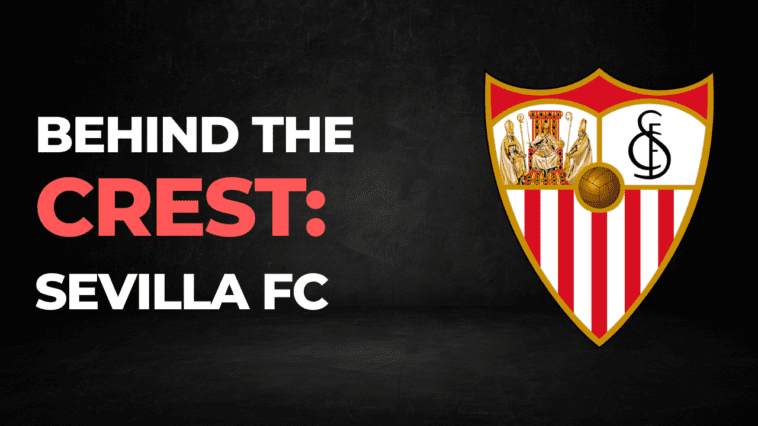Behind the Crest is a series where we unravel the story behind Football’s unique crests.
Sevilla FC is a historic football and one of the oldest clubs in Spain. They are the most successful team in the UEFA Europa league making them a European royalty.
Sevilla’s Crest reflects the region’s cultural heritage, and its heroic history and represents a visual narrative of the club’s journey. Keep reading as we look into the history of Sevilla’s Crest.
The Story Behind Sevilla’s Crest
What is Sevilla FC?
Sevilla Futbol Club is a Spanish professional football club founded in Seville. It was founded on 25th January 1890 making it one of the oldest clubs in Spain.
However, the club did not adopt a formal logo until much later. In its initial years, Sevilla FC’s identity was fluid but later on they have had a variety of crests.
History of Sevilla’s Crest.
1908

Sevilla was founded in 1980 but wasn’t registered until 15 years so the club didn’t get a unique identity until 1908 when Sevilla got its first crest.
The First crest was quite simple it consisted of Sevilla FC’s Initials ‘SFC’ written in Red inside a red circle. And this was the theme of Sevilla’s crest for more than a decade with only minor changes.
1909

A year after getting its first crest Sevilla also used a black and white version of their emblem for administration purposes. This design was handmade and along with the club’s initials, it also had the club’s name written on the outer ring.
The majority of founding members of Sevilla FC were of British origin and thus Sevilla uses the English name Sevilla Futbol Club instead of the Spanish name Club de Futbol.
1915

After a few years, Sevilla gave their crest a neat design. It had the initials and the name of the club typed on inside the circle and the club’s official registration year ‘1905’ was also added at the bottom.
1921

In 1921 Sevilla’s crest saw its first major change. Sevilla chose a heraldic shield as the shape of their new crest as it represented the city’s heritage. The Shield was divided into three sectors with golden fields and at the center it had a football resembling a six-pointed swastika.
On the Right side of the shield, the Intials of Sevilla were presented in RED color on a white background. On the left of it were the three saints and at the bottom were 11 red and white stripes resembling the club’s colors.
The Saints
The three saints or The Trinity is the main element of the city coat of arms of Sevilla. In the center of the image, we see Ferdinand III, the King of Castile, sitting on the throne with a sword.


Ferdinand III of Castile is one of the most significant kings in Spanish history. In 1248, he liberated the city from the Moors. On the side stand archbishops Isidor and Leander of Seville. These are the largest Spanish church figures of the 6th-7th centuries.
The Red and White Stripes.
There are a couple of theories regarding Sevilla’s club colors and the red and white stripes on its crest.
The first one is that when the club was formed, the members wished that the first official jersey of the club to be in Red and white color.
The second one is that the red and white stripes represent the colors of colors of the flag of Castile, under which Ferdinand III’s Christian army besieged Muslim Sevilla.
1995
After 1921 this crest became Sevilla’s new identity and only underwent minor changes with the latest one coming in the year 1995.
Here the Club initials can be seen in black instead of red and the golden ball at the center was replaced by a brown ball.
Conclusion :
Sevilla FC’s crest is more than an emblem; it’s a narrative of the club’s journey and Seville’s cultural roots. From the simplicity of the early 1900s to the heraldic shield in 1921, each iteration tells a story of resilience and identity.
The incorporation of saints, the red and white stripes, and the evolution into the emblem we recognize today showcase Sevilla’s commitment to preserving tradition while embracing the dynamism of football’s ever-changing landscape.
The crest stands not only as a mark of the club’s history but also as a timeless emblem of Sevilla’s enduring legacy.



